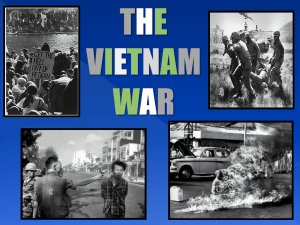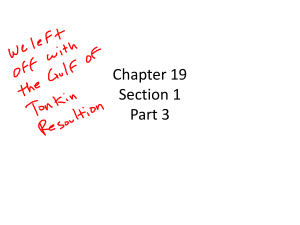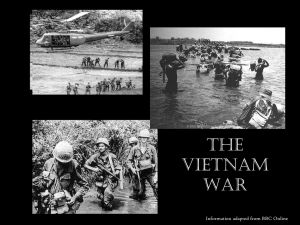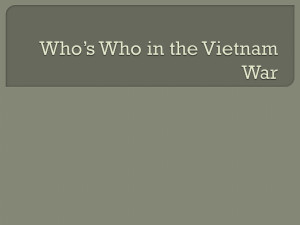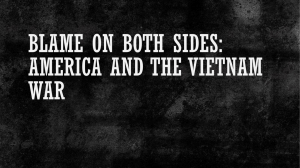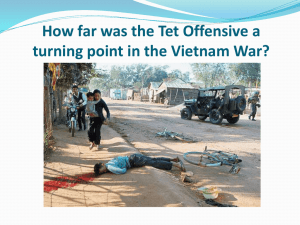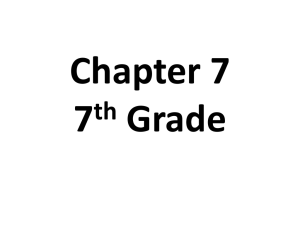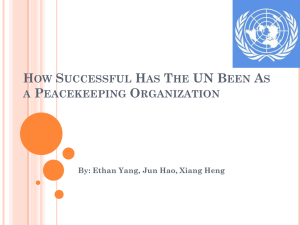Chapter 29 Section 2 U.S. Involvement Grows
advertisement
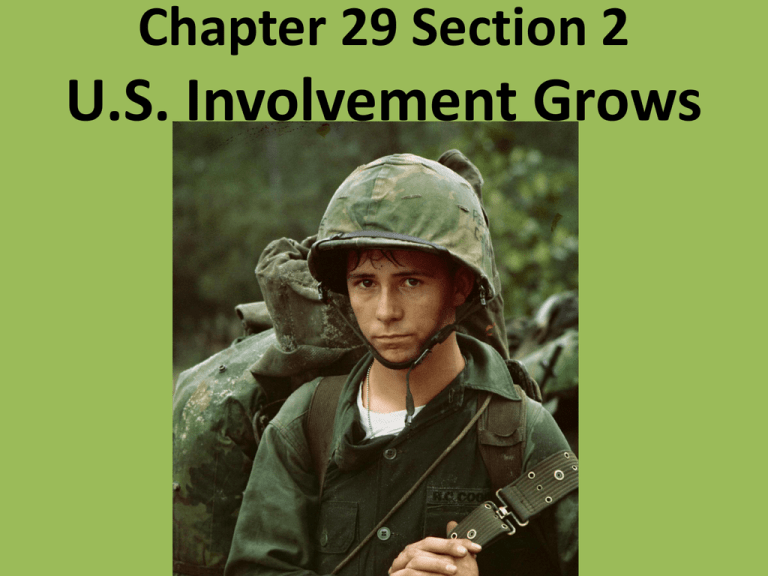
Chapter 29 Section 2 U.S. Involvement Grows “Americanizing” the War • Secretary of Defense Robert McNamara and General William Westmoreland, Commander US Forces in South Vietnam believed the US needed to increase its military presence in South Vietnam beyond the role of advisors to the South Vietnamese Armed Forces (ARVN) • This called for more troops and airstrikes against targets in North and South Vietnam General William Westmoreland Commander US Forces in South Vietnam Robert McNamara Secretary of Defense An American door gunner covering ARVN troops A Green Beret on patrol with ARVN troops US Helicopters prepare to transport ARVN troops into battle, 1965 Rolling Thunder • In March 1965, following a Vietcong attack on US troops at Pleiku, President Johnson ordered the bombing of North Vietnam • Code named “Operation Rolling Thunder” • Air Force, Navy, and Marine Corps warplanes attacked strategic targets in North Vietnam and Vietcong strongpoints in South Vietnam • Lasted until November 1968 Phillipsburg HS graduate 1st Lieutenant (later Major) Bruce Lawrence, KIA July 5, 1968 over North Vietnam when his F4 Phantom was hit by a surface-to-air missile (SAM) F-4 Phantom North Vietnamese SA-2 SAM Agent Orange • Agent Orange is a chemical used by the U.S. Army in the Vietnam War from 1961 to 1971 to remove forest cover, destroy crops, and disrupt agriculture food production. • It is called “Agent Orange” because of the orange band that identifies the barrel the chemical came in. There were also Agents Purple, Green, and Pink. Agent Orange • The U.S. military dumped some 20 million gallons of Agent Orange and other herbicides on about a quarter of former South Vietnam between 1962 and 1971. • The defoliant decimated about 5 million acres of forest — roughly the size of Massachusetts — and another 500,000 acres of crops, the report said. Agent Orange • The chemical have been shown to cause serious skin diseases as well as a vast variety of cancers in the lungs, larynx, and prostate. Other effects include cleft palate, mental disabilities, hernias, and extra fingers and toes. • The scariest impact is that the disease and deformities caused by the chemical can span across generations. The Marines Land • On March 8, 1965, US Marines arrived to defend the airbase at Da Nang. More troops soon followed. • By the end of 1965, there were 184,300 US troops in Vietnam • 636 Americans had been killed in the war to date March 8, 1965- The first deployment of U.S. battalion-sized U.S. combat units to Vietnam Pictured are Marines from 3rd Battalion, 9th Regiment The 1st and 3rd Battalions soon followed, bringing the strength of the 9th Marine Expeditionary Brigade up to 5,000 troops. The Vietcong • The Vietcong (VC) were South Vietnamese communists fighting for unification with North Vietnam • They waged guerilla warfare, dressed as civilians and hid after attacking US troops • They were supplied by the North Vietnamese by the Ho Chi Minh Trail that went through Laos and Cambodia • The VC were highly motivated and suffered great hardships The Vietcong and North Vietnamese dug a complex series of tunnels, from which they mounted surprise attacks. The U.S. dropped napalm to burn these jungle hideouts. Mounting Costs • By the end of 1968, 500,000 US troops were in country • Over 30,000 Americans had been killed Friend or Foe? • The VC looked no different from the average civilian • Women and children were often used to attack US troops • The VC used booby traps, mines and human bombs to kill US troops Vietcong & NVA Strategy • The VC and NVA knew they could not match US firepower • They relied on hit-and-run tactics to harass American forces • Many attacks occurred at night • The goal was to erode American’s will to fight through attrition U.S. Troops Fulfill Their Duty • Americans served in Vietnam for a variety of reason • Many volunteered to serve their country • Some fought to stop communism • Some fought to protect the South Vietnamese • Many were drafted and had no choice but to serve Morale Declines • Morale declined for many reasons – The majority of troops after 1965 were draftees – Losses continued to mount – US Troops felt the South Vietnamese people were indifferent to their presence and should be defending their own country – A growing anti-war movement at home undermined morale Economic Problems at Home • Johnson’s Great Society programs were very expensive • The cost of fighting in Vietnam was also very high • Massive government spending had lowered the unemployment rate but inflation was very high • These factors led to increased taxes The Anti-War Movement • By 1967, opposition to the war was widespread • Two camps had emerged, Doves and Hawks • Doves questioned the war. They included liberal politicians and students who saw the conflict as a localized civil war. • Hawks supported Johnson’s war policies. They were mostly conservatives who believed the war was crucial to a U.S. Cold War victory. Phillipsburg’s Roll of Honor 13 of the 58,272 listed on the Wall attended Phillipsburg High School Major Bruce Edward Lawrence Pilot (Phillipsburg, NJ) 557th Tactical Fighter Squadron USAF Tour of duty began on November 9,1968 KIA July 5, 1968 Surface-to-Air Missile Hit North Vietnam PHS Class of 1960 Staff Sergeant Terrance Edward Smith Infantry (Phillipsburg, NJ) 25th Infantry Division USA Tour of duty began on April 23, 1967 KIA March 24, 1968 Enemy Action Tay Ninh Province Attended PHS 1962 Silver Star Citation (Posthumous) For Gallantry in Action, Staff Sergeant Smith distinguished himself by heroic actions on March 24, 1968, while serving as a platoon sergeant with Company B, 2nd Battalion, 14 Infantry on a combat operation in the Republic of Vietnam. When his unit was pinned down by intense enemy fire, Sergeant Smith reacted instantly to the situation and led his platoon to protective cover. He repeatedly exposed himself to the enemy fire to direct his men's fire and when a group of his men were trapped by the enemy fire he maneuvered to their position. After maneuvering these men to within 25 meters of the friendly positions, Sergeant Smith was mortally wounded by the intense enemy fire. His valorous actions saved several lives and were of immeasurable value to the successful completion of the mission. Private First Class James Robert Morris Rifleman (Phillipsburg, NJ) 3rd Battalion 7th Marine Regiment USMC Tour of duty began on November 28,1967 KIA January 31, 1968 Enemy Action Quang Nam Province PHS Class of 1964 Sergeant Albert Aleya Outwater Jr Platoon Guide (Phillipsburg, NJ) 3rd Battalion 3rd Marine Regiment USMC Tour of duty began on July 17,1967. KIA July 21, 1967 Enemy Action Quang Tri Province PHS Class of 1964 Corporal Albert Shiller Rifleman (Alpha, NJ) 9th Infantry Division USA Tour of duty began on November 12, 1967 KIA April 2, 1968 Wounds received from enemy booby trap Binh Duong Province PHS Class of 1964 Specialist 4 Daniel John Myers (Stewartsville, NJ) 1st infantry Division USA Tour of duty began on July 27, 1966 KIA January 30, 1967 Non-Hostile Vehicle Accident Di An, South Vietnam PHS Class of 1965 Specialist 4 Dennis Kline (Phillipsburg, NJ) 25th Infantry Division USA Tour of duty began on July 15, 1966 KIA March 21, 1967 Friendly Fire (Air Strike) Hug Nghia Province PHS Class of 1965 Private Robert John Marcantoni Rifleman (Phillipsburg, NJ) 3rd Battalion 7th Marine Regiment USMC Tour of duty began on April 23, 1967 KIA April 10, 1968 Enemy Action Quang Nam Province PHS Class of 1965 Warrant Officer 1st Class William M. Konyu Bell UH-1H Helicopter Pilot (Phillipsburg, NJ) 101st Airborne Division USA MIA April 16, 1969 Helicopter Crash-Hostile Fire Quang Nam Province PHS Class of 1965 Sergeant James L. Suydam (Phillipsburg, NJ) 199th Light Infantry Brigade USA MIA October 9, 1969 Non Hostile Helicopter Crash Tay Ninh Province PHS Class of 1966 Private First Class Arthur Mortimer Rowe Rifleman (Phillipsburg, NJ) 2nd Battalion 1st Marine Regiment USMC Tour of duty began on April 12, 1968 WIA- May 19, 1968 DOW- June 1, 1968 Enemy Action Khe Sahn Attended PHS 1966 Private First Class Robert Franklin Bacon Trooper (Phillipsburg, NJ) 1st Air Cavalry Division USA Tour of duty began on June 3, 1969 KIA July 17, 1969 Enemy Action Binh Duong Province Attended PHS 1966 Corporal John Edgar Marason Armored Vehicle Crewman (Phillipsburg, NJ) 173 Airborne Brigade USA Tour of duty began on November 9,1968 KIA December 2, 1968 Enemy Action Binh Dinh Province PHS Class of 1967
